太阳能海水淡化系统的第一性原理与人工神经网络模型的实验验证
IF 1.8
4区 数学
Q3 COMPUTER SCIENCE, INTERDISCIPLINARY APPLICATIONS
Mathematical and Computer Modelling of Dynamical Systems
Pub Date : 2020-07-12
DOI:10.1080/13873954.2020.1788609
引用次数: 10
摘要
摘要本研究主要致力于通过圆柱形抛物面收集器和太阳能电池板来提高太阳能蒸馏器的性能。300W的太阳能电池板用于通过太阳能蒸馏器单元外部的热元件来加热盐水。太阳能电池板在一天中的高温时段被冷却;因此,降低它们的温度可以导致太阳能电池板效率的提高,随后太阳能蒸馏器单元的效率的提高。实验中使用的最大淡水量为2.132千克/天。实验使用人工神经网络建模。基于神经网络仿真结果,实验数据与神经网络建模之间存在显著相关性。本文将实验数据与数学模型和人工神经网络的数据进行了比较。因此,人工神经网络预测比所提出的简化第一原理模型更准确。本文章由计算机程序翻译,如有差异,请以英文原文为准。
First principles versus artificial neural network modelling of a solar desalination system with experimental validation
ABSTRACT The present study mainly focuses on enhancing the performance of solar still unit using solar energy through cylindrical parabolic collector and solar panels. A 300 W solar panel is used to heat saline water by thermal elements outside the solar still unit. Solar panels are cooled during the hot hours of the day; thus, reducing their temperature may lead to an increase in solar panel efficiency followed by an increase in the efficiency of the solar still unit. The maximum amount of freshwater used in the experiment was 2.132 kg/day. The experiments were modelled using ANNs. Based on neural network simulation results, there is a significant correlation between experimental data and neural network modelling. This paper compares experimental data with data obtained from mathematical modelling and ANNs. As a conclusion, the artificial neural network prediction has been more accurate than the simplified first principles model presented.
求助全文
通过发布文献求助,成功后即可免费获取论文全文。
去求助
来源期刊
CiteScore
3.80
自引率
5.30%
发文量
7
审稿时长
>12 weeks
期刊介绍:
Mathematical and Computer Modelling of Dynamical Systems (MCMDS) publishes high quality international research that presents new ideas and approaches in the derivation, simplification, and validation of models and sub-models of relevance to complex (real-world) dynamical systems.
The journal brings together engineers and scientists working in different areas of application and/or theory where researchers can learn about recent developments across engineering, environmental systems, and biotechnology amongst other fields. As MCMDS covers a wide range of application areas, papers aim to be accessible to readers who are not necessarily experts in the specific area of application.
MCMDS welcomes original articles on a range of topics including:
-methods of modelling and simulation-
automation of modelling-
qualitative and modular modelling-
data-based and learning-based modelling-
uncertainties and the effects of modelling errors on system performance-
application of modelling to complex real-world systems.

 求助内容:
求助内容: 应助结果提醒方式:
应助结果提醒方式:


